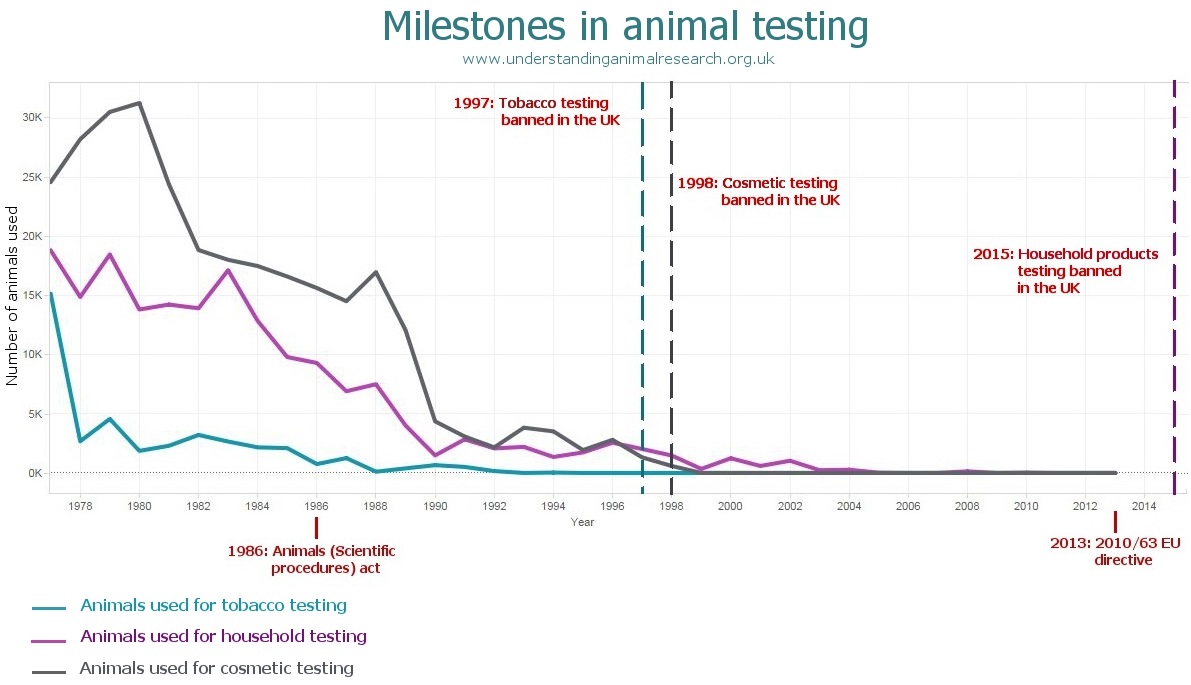The United Kingdom reports a wealth of information every year on its use of animals in research. Every animal procedure must be categorized according to the overall purpose (and specific disease area or regulatory purpose if relevant), the genetic status of the animals and the severity of the procedure. Historically, Great Britain (England, Scotland and Wales) conducts approximately 99.5% of procedures, which are regulated by and reported by the UK Home Office. Northern Ireland has not yet released animal use statistics for 2021.
Animal Research in the United Kingdom (excluding Northern Ireland)

Every year the Home Office releases the statistics on animal research in Great Britain (Northern Ireland released separately) for the preceding year. In 2021, the total number of procedures on animals was 3.06 million, an increase of 6% from the 2.88 million in 2020.

The total number of animals used is quite likely lower as some animals were used for more than one procedure*. In 1987 the UK changed the way in which it counted animals, from the total number of animals to the total number of procedures. There was a further, smaller change to methodologies in 2014.
*The total number of animals excludes those animals first used in a previous year, which underwent a procedure in the current year, in order to prevent double counting of animals between years.
The last few years have seen the number of Genetically Altered animals (mainly GA mice) being bred rising as a proportion of all studies; this accounts for 43% of all procedures (in 2021). Other common uses included basic research (51%), regulatory purposes (21%), translational/applied research (27%) and for other purposes (1%).
Broadly speaking, basic research involves investigation into understanding key mechanisms via which something occurs or functions. The most common areas focused upon in basic research were the nervous system (23%), immune system (20%) and oncology (12%). In contrast, applied research attempts to address diseases through prevention and development of treatments. The most common areas of research were animal diseases and disorders (48%), human cancer (15%), and human infectious disorders (12%). Finally, regulatory research is carried out to satisfy the legal requirements necessary to enable materials, products, and devices to be licensed for use. Regulatory procedures are usually carried out during the final stages of research and development and focuses on safety and efficacy. The most common procedure in 2021 was toxicity and other safety testing (52%).
“This year there has been a large increase in the proportion of applied research which has increased from 10% in 2020 to 27% in 2021. Whilst there was a large decrease in the proportion of regulatory procedures, which has decreased from 33% in 2020 to 21% in 2021. The rest of the purposes for experimental procedures have remained relatively stable since 2014.”
Looking at the species used we can see, mice, rats, birds and fish account for over 96% of all procedures on animals in Great Britain. Dogs and cats account for 0.14% and primates account for around 0.09%. Invertebrates such as fruit flies and nematode worms are widely used by researchers but are not covered by the Animals (Scientific Procedures) Act and are thus not included. The only invertebrate included in the statistics are cephalopods, though none have been used in recent years.

The UK statistics include retrospective reporting of suffering. Rather than just submitting license proposals to the Home Office that include estimated levels of suffering, the researchers now have to report on what was actually seen (using a variety of measures). Unfortunately, the statistics put these in two separate tables (Table 3.1 and 8). We have combined them to get severity for all procedures in 2021 – see definitions on page 23 or click here). It shows that 83.7% of procedures are sub-threshold, non-recovery or mild, and involved minimal pain or suffering for the animals. 13% of studies were moderate and 3% were severe.

It is also important to realize that no animal research or testing was done for:
- Tobacco products (banned in 1997)
- Cosmetic products or ingredients (banned in 1998)
- Household products (banned in 2015)

When we look at the other uses of animals in the UK we see that those killed for medical research (and the huge benefits that go with it) are far outweighed by the numbers of fish and chickens eaten, and even by the number of birds and other wildlife killed by domestic cats.

Finally, it is worth remembering the huge benefits brought about by animal research. Here are some annual figures of treatment used that were developed through animal research.

Table sources:
- 7,824 isolated aortic valve replacements or AVR + coronary artery bypass graft in 2012. Cardiovascular Disease Statistics 2015 by British Heart Foundation.
- 55,200 people are diagnosed with breast cancer every year in the UK according to CRUK.
- 421,000 diabetic insulin users in the UK in 2010. Holden SE et al (2014).
- 2,766,600 general anaesthetic cases + 523,100 local anaesthetic cases = 3,289,700 cases. NHS anaesthesia survey 2013.
- 30,825,400 Bronchodilators prescribed in UK in 2015. HSCIC Prescriptions 2015.
- 39,363,800 antibacterial drugs prescribed in 2015. HSCIC Prescriptions 2015.
Animal Research in Northern Ireland
In Northern Ireland, animal research statistics are compiled by the Department of Health, Social Services and Public Safety in Northern Ireland (as opposed to the UK Home Office, as in England, Scotland and Wales).
Animal research in Northern Ireland accounts for 0.01% of the total animal research in the UK. In 2018 the number of procedures was 28,171, and increase of 2.2% from 2018.

Since the number of procedures involving the creation and breeding of GM animals is much lower than in the UK (and these are often sub threshold), the proportion of sub threshold procedures is much lower than the rest of the UK, though this proportion is rising. The number of severe procedures is similar to the rest of the UK, but there is a higher proportion of moderate severity procedures.

